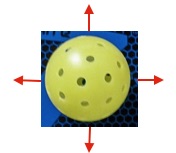As more advanced players know, the third shot drop shot can be a powerful weapon. On the downside, it is a high risk-high reward shot for many casual players.
What to do in the following scenario:
Your team serves the ball high and deep. The other team now returns a nice deep shot and both the players are near the kitchen (NVZ). The opponents both have good volley skills and are waiting for your next shot…
A – You can try to over power them by hitting the ball hard to one of the weaker spots, i.e. backhand which is not that easy since the margin of error is narrow.
B – You can lob the ball to try to move at least one player off of the kitchen line, but this too takes a bit of touch; too short and it gets whacked, too long and it is out.
C – Third shot drop shot. Get the ball over the net into the middle of the NVZ and move the game to the net where it would then become a “touch” game. Once again, high risk-high reward. Too long and the ball is smashed back at you; too short and it goes into the net.
When playing against skilled pickleballers, the choices may all seem difficult. Why not work on that third shot which may be the best opportunity in the above scenario?
To make it even more of a problem, the Third Shot technique is a bit different from various places on the court. It is a “touch” shot and the paddle position, pace, etc. needs to be altered as the ball is hit either longer or shorter onto your side of the court.
Deb Harrison demonstrates how to practice the Third Shot Drop from various positions on the court. I know this is one area I need to practice quite a bit. I am decent near the NVZ, but pretty bad when it comes to executing the desired third shot from the baseline.
From the YouTube synopsis:
Published on Oct 1, 2016
“This video emphasizes the need for players to develop the ability to execute a 3rd shot drop from various types of balls into the NVZ (No Volley Zone) from all areas on the court. Drills to practice dropping short hop and long hop balls are shown. The key is, depending on the type of hop, opening the paddle to the right angle UNDER the ball and using the pace to determine how much forward motion is needed. Remember that the net is your first opponent and MOST importantly, your drop HAS to go over the net. There is a lot of “feel or touch” to the execution of these skills, so more practice = more success!”
To See Pickleball Videos Covering Many Aspects of the Game Click Here (primarily for beginners and less experienced players)
Check out Additional Pickleball Info and Videos! (for all players including average to more experienced players)







